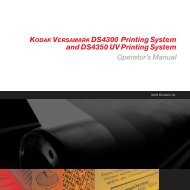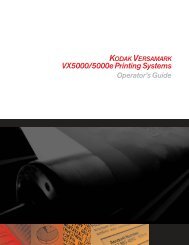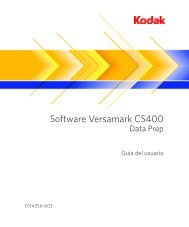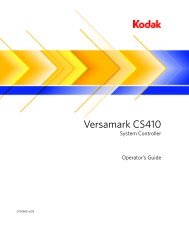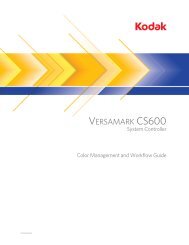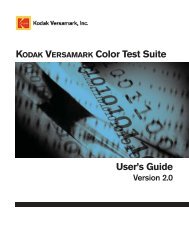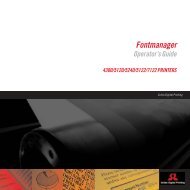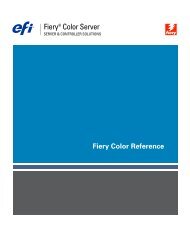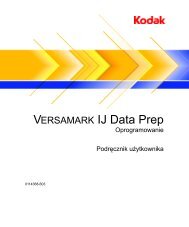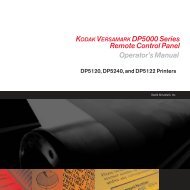digit printers theory.book - Kodak
digit printers theory.book - Kodak
digit printers theory.book - Kodak
Create successful ePaper yourself
Turn your PDF publications into a flip-book with our unique Google optimized e-Paper software.
KODAK VERSAMARK DP5000 Series Printers<br />
Theory of Operation<br />
DP5120, DP5122, and DP5240<br />
<strong>Kodak</strong> Versamark, Inc.
KODAK VERSAMARK DP5000-Series Printers<br />
Theory of Operation<br />
DP5120/DP5240/DP5122 Printers
FCC Compliance Statement<br />
This equipment has been tested and found to comply with the limits for a Class A <strong>digit</strong>al device, pursuant to Part 15 of the FCC Rules. These<br />
limits are designed to provide reasonable protection against harmful interference when the equipment is operated in a commercial environment.<br />
This equipment generates, uses, and can radiate radio frequency energy and, if not installed and used in accordance with the instruction manual,<br />
may cause harmful interference to radio communications. Operation of this equipment in a residential area is likely to cause harmful interference,<br />
in which case the user will be required to correct the interference at his own expense.<br />
Note: Good quality, shielded (braided shielded) cables must be used for the RS-232-C and Centronics interfaces.<br />
Canadian EMI Compliance Statement<br />
Le présent appareil numérique n’émet pas de bruits radioélectriques dépassant les limites applicables aux appareils numériques de la classe A<br />
prescrites dans le Règlement sur le brouillage radioélectrique édicté par le ministère des Communications du Canada.<br />
This <strong>digit</strong>al apparatus does not exceed the Class A limits for radio noise emissions from <strong>digit</strong>al apparatus set out in the Radio Interference Regulations<br />
of the Canadian Department of Communications.<br />
EMI-CISPR 22/EN 55 022/CE Marking<br />
Warning: This is a Class A product. In a domestic environment, this product may cause radio interference in which case the user may be<br />
required to take adequate measures.<br />
KODAK VERSAMARK DP5000-Series Printers Theory of Operation, DP5120/DP5240/DP5122 Printers<br />
Part Number Media Revision Date Description ECN<br />
0113846-602<br />
0113846-603<br />
Print<br />
PDF<br />
001 04/01 Extracted from 0113851 and revised for the DP5122 Printer K44798<br />
© Eastman <strong>Kodak</strong> Company, March 4, 2005. All rights reserved.<br />
This document contains proprietary information of <strong>Kodak</strong> Versamark, Inc. or its licensors and is their exclusive property. It may not be<br />
reproduced without a written agreement from <strong>Kodak</strong> Versamark, Inc. No patent or other license is granted to this information.<br />
The software described in this document is furnished under a license agreement. The software may not be used or copied except as provided<br />
in the license agreement.<br />
<strong>Kodak</strong> Versamark, Inc. makes no warranty of any kind with regard to the contents of this document, including, but not limited to, the implied<br />
warranties of merchantability and fitness for a particular purpose. <strong>Kodak</strong> Versamark shall not be liable for any errors or for compensatory,<br />
incidental or consequential damages in connection with the furnishing, performance, or use of this document or the examples contained herein.<br />
Information concerning products not manufactured by <strong>Kodak</strong> Versamark, Inc. is provided without warranty or representation of any kind, and<br />
<strong>Kodak</strong> Versamark, Inc. will not be liable for any damages resulting from the use of such information.<br />
<strong>Kodak</strong> and Versamark are trademarks of Eastman <strong>Kodak</strong> Company.<br />
0113846-602<br />
0113846-603 03/2005 Printed in U.S.A.
Scope<br />
Theory of operation provides general, technical background for the following<br />
<strong>Kodak</strong> Versamark products:<br />
• DP5120 Printer and DS5120 Printing System<br />
• DP5240 Printer and DS5240 Printing System<br />
• DP5122 Printer and DS5122 Printing System<br />
This guide is part of the following service manual set:<br />
• Volume 1 (0113902-001)<br />
Theory of Operation (0113846)<br />
Service Guide (0113864)<br />
• Volume 2 (0113902-002)<br />
Illustrated Parts List (0113783)<br />
Service Diagrams (0113874)<br />
Installation Guide (0113847)<br />
The information in this guide is intended only for a <strong>Kodak</strong> Versamark field<br />
engineer, or a service technician trained by <strong>Kodak</strong> Versamark, Inc.<br />
Theory of Operation<br />
iii
Scope<br />
Text Notations<br />
Text Notations<br />
This manual uses the following typographical conventions.<br />
This style<br />
Ready<br />
go<br />
ENTER<br />
[NEXT]<br />
Save<br />
File → Open<br />
ALT+F1<br />
ALT, TAB<br />
xx,yy<br />
jobfile.dat<br />
Refers to<br />
Text displayed by the software.<br />
Anything you type, exactly as it appears, whether referenced<br />
in text or at a prompt.<br />
Special keys on the keyboard, such as enter, alt, and<br />
spacebar.<br />
Buttons and lights on the printer operator panel.<br />
Software command buttons and sections of dialog boxes,<br />
such as group boxes, text boxes, and text fields.<br />
A menu and a specific menu command.<br />
Pressing more than one key at the same time.<br />
Pressing more than one key in sequence.<br />
Variable in error messages and text.<br />
File names.<br />
Safety Notations<br />
The following definitions indicate safety precautions to the operator.<br />
Note: Information that needs to be brought to the reader’s attention.<br />
Caution: A situation where a mistake could result in the destruction of data or system-type<br />
damage.<br />
! WARNING<br />
A potential hazard that could result in serious injury or death.<br />
! DANGER<br />
An imminent hazard that will result in serious injury or death.<br />
iv<br />
DP5000 Series Printers
Scope<br />
Service and Support<br />
Service and Support<br />
Technical equipment support is available 24 hours a day, 7 days a week.<br />
Software and applications support is available 8:00 a.m. to 5:00 p.m. EST/EDT,<br />
Monday through Friday.<br />
Call for telephone or on-site technical support; to order parts or supplies;<br />
to request documentation or product information.<br />
U.S.A., Canada, and<br />
worldwide<br />
Phone<br />
+1-800-472-4839<br />
+1-937-259-3739<br />
Fax<br />
+1-937-259-3808<br />
Europe +41-21-806-0404 +41-21-806-1920<br />
Asia/Pacific Rim +65-6744-6400 +65-6744-6700<br />
Japan +81-3-3256-2613 +81-3-3256-2616<br />
Updated service<br />
information<br />
Customer support<br />
http://www.kodakversamark.com<br />
customer@kodakversamark.com<br />
Theory of Operation<br />
v
Contents<br />
Chapter 1. Overview<br />
Inkjet Printing Basics ......................................................................................... 1-1<br />
Pressure...................................................................................................... 1-1<br />
Stimulation .................................................................................................. 1-1<br />
Charge ........................................................................................................ 1-2<br />
Vacuum ....................................................................................................... 1-2<br />
Component Functions........................................................................................ 1-3<br />
Printhead Functions .................................................................................... 1-3<br />
Common Printing Sequence................................................................. 1-4<br />
Internal Differences............................................................................... 1-5<br />
Umbilical...................................................................................................... 1-5<br />
Fluid System ............................................................................................... 1-6<br />
Data System................................................................................................ 1-7<br />
Functionality and Reliability ............................................................................... 1-8<br />
General Guidelines ..................................................................................... 1-8<br />
Fluid System Guidelines.............................................................................. 1-8<br />
Chapter 2. Printer Functions<br />
Power Distribution.............................................................................................. 2-1<br />
Data System ...................................................................................................... 2-2<br />
Machine Control................................................................................................. 2-3<br />
Host Communication ......................................................................................... 2-4<br />
Startup......................................................................................................... 2-4<br />
Printing ........................................................................................................ 2-5<br />
Shutdown .................................................................................................... 2-6<br />
Chapter 3. Controller Functions<br />
System Overview............................................................................................... 3-1<br />
System Configuration.................................................................................. 3-1<br />
Software ...................................................................................................... 3-2<br />
Interfaces .................................................................................................... 3-3<br />
Controller Operation .......................................................................................... 3-4<br />
Data Source ................................................................................................ 3-5<br />
Tach and Cue.............................................................................................. 3-6<br />
Print Control ................................................................................................ 3-7<br />
Layout ......................................................................................................... 3-7<br />
Index<br />
Theory of Operation<br />
vii
Figures<br />
Figures<br />
Figure 1.1 Printer components ..................................................................... 1-3<br />
Figure 1.2 Fluid system operation, DP5240 and DP5122 Printers............... 1-6<br />
Figure 1.3 Data system components, DP5240 and DP5122 Printers .......... 1-7<br />
Figure 2.1 Major printer sub-systems........................................................... 2-1<br />
Figure 2.2 Power distribution, printer ........................................................... 2-2<br />
Figure 2.3 Signal and data flow, data system .............................................. 2-3<br />
Figure 2.4 Signal flow, machine control sub-system .................................... 2-4<br />
Figure 2.5 Startup communications sequence, printer and host .................. 2-5<br />
Figure 3.1 Communications paths, system configuration............................. 3-5<br />
Tables<br />
Table 3.1 System configurations, DP5000-Series Printers ..................... 3-2<br />
Table 3.2 Interface functions, DP5000-Series Printers ........................... 3-4<br />
viii<br />
DP5000 Series Printers
Chapter 1.<br />
Overview<br />
General knowledge of the following subjects is necessary to effectively<br />
troubleshoot and repair KODAK VERSAMARK DP5000-Series products:<br />
• Inkjet printing basics<br />
• Component functions<br />
• Functionality and reliability<br />
Inkjet Printing Basics<br />
Inkjet printing is the process of placing small drops of ink onto a printing<br />
surface in a pattern that produces an image. The type of inkjet printing<br />
used in the DP5000-Series is continuous-flow, binary, multiple-jet array<br />
imaging. Continuous inkjet printing requires the following four elementary<br />
forces:<br />
• Pressure<br />
• Stimulation<br />
• Charge<br />
• Vacuum<br />
How these forces interact in an inkjet printhead is best understood by<br />
“building” a printhead and describing how the major printhead<br />
components harness these forces to create a printed, inkjet image.<br />
Pressure<br />
Pressure is produced by the ink pump that moves ink from the ink tank<br />
(supply) to the drop generator in the printhead. Printhead pressure, also<br />
called “bar pressure,” is measured in pounds per square inch (psi).<br />
Pressure must be sufficient to force ink through the orifices to create<br />
filaments, but not excessive. Low pressure results in ink starvation at the<br />
printhead. Complete loss of pressure prevents printing because no ink is<br />
available to form jets. Excessive pressure can cause an internal leak or<br />
ink spill. Normal operating pressure is about 9.5 psi in the DP5120 and<br />
DP5122 Printers and about 19 psi in the DP5240 Printer.<br />
Stimulation<br />
Stimulation is produced in the printhead by mechanical action of the<br />
droplet generator. Piezoelectric crystals are bonded to the droplet<br />
generator and excited. The resulting sinusoidal wave form produces<br />
vibration communicated to the orifice plate. The vibration breaks up the<br />
ink filaments passing through the jets into uniform drops.<br />
Theory of Operation 1 - 1
Chapter 1. Overview<br />
Inkjet Printing Basics<br />
Stimulation is measured by frequency. The DP5120 and DP5122 Printers<br />
use a stimulation frequency of 50 kilohertz (kHz); this creates 50,000 ink<br />
drops per second at each jet. The DP5240 Printer uses 100 kHz<br />
stimulation frequency that creates 100,000 drops per second at each jet.<br />
The correct stimulation frequency setting, typically called the “stim”<br />
setting, is critical to proper printhead operation and must be determined<br />
for the printhead by test printing. To achieve the proper stim setting,<br />
phase and voltage are adjusted within a range called a “window.”<br />
Prolonged over-stimulation causes printhead short-circuits (shorts), print<br />
voids and eventually damage to the printhead electronics. Understimulation<br />
causes streakers, dark areas (ink saturation), and eventually<br />
printhead failure. Total stim failure prevents printing, as all jets stay in<br />
catch and no ink reaches the substrate. Stimulation failures are rare, but<br />
the usual cause is a bad resonator or crystal that requires replacing the<br />
printhead.<br />
Charge<br />
The DP5000-Series Printers use electrical charge to designate which<br />
droplets are to reach the printing surface. When they leave the orifice<br />
plate tunnels, the ink jets carry no electrical charge. As the jets fall toward<br />
the printing surface and break into drops, they pass close to the charge<br />
plate and catcher. The charge plate can have either a positive charge<br />
(+100 to +180 volts DC) or no charge. Formatted print data (a bit map)<br />
from the character generator controls the charge on the charge plate and<br />
determines the droplets to be used for printing.<br />
A positive charge on the charge plate induces a negative charge in the<br />
droplets as they break away from the jet. The negatively charged droplets<br />
are attracted by the positive charge plate. This attraction changes the<br />
trajectory of the droplets, causing them to hit the catcher.<br />
If the charge plate has no charge, the ink remains electrically neutral<br />
when it forms droplets. The neutral droplets fall past the charge plate and<br />
catcher and hit the printing surface. Total charge failure results in an ink<br />
dump, all jets printing constantly which quickly saturates the substrate.<br />
Excessive charge causes high-voltage shorts and prolonged high voltage<br />
can etch the charge leads and damage the printhead.<br />
The DP5120 charge plate contains 128 charge areas, one for each jet.<br />
The charge on each area can be changed quickly enough to selectively<br />
pass or deflect each of the 50,000 droplets passing it each second; thus,<br />
charge allows the DP5120 Printer to control 6,400,000 drops per second.<br />
The DP5240 and DP5122 charge plates contain 256 charge areas and<br />
passes or deflects each of the 100,000 droplets, allowing these <strong>printers</strong> to<br />
control 25,600,000 drops each second.<br />
Vacuum<br />
Vacuum recovers and recirculates deflected drops. Charged drops hit the<br />
catcher face as they fall past the charge plate. Vacuum draws the ink on<br />
the catcher back into the fluid system where it is returned to the ink tank.<br />
Vacuum also assists the fluid system in maintaining the ink supply. As ink<br />
is used, ink or replenisher is drawn from the appropriate bottle into the<br />
tank. Vacuum failure results in ink collecting in the printhead. Excess ink<br />
in the printhead housing will eventually result in leaks or shorts.<br />
1 - 2 DP5000 Series Printers
Chapter 1. Overview<br />
Component Functions<br />
Component Functions<br />
The basic functions of the following printer sub-systems are described:<br />
• Printhead<br />
• Umbilical<br />
• Fluid system<br />
• Data system.<br />
The printer enclosure physically contains the fluid system and data<br />
system. The umbilical connects the printhead to the enclosure. See<br />
Figure 1.1.<br />
Figure 1.1<br />
Printer components<br />
Umbilical<br />
Printhead<br />
Data System<br />
Fluid System<br />
The controller PC, software, and interfaces are the major components of<br />
a printing system that contains a DP5000-Series Printer. Printing system<br />
functions are described in Chapter 3.<br />
Printhead Functions<br />
DP5000-Series Printers have the following printheads:<br />
• DH5120 Printhead<br />
This 120-jet array prints 1.06 inches (2.69 cm) wide with vertical<br />
resolution of 120 dots per inch (dpi) and horizontal resolution of 120<br />
or 240 dpi.<br />
• DH5240 Printhead<br />
This 240-jet array prints the same width as the DH5120, but at a<br />
vertical resolution of 240 dpi, and a horizontal resolution of 240 dpi or<br />
480 dpi.<br />
• DH5122 Printhead<br />
This 240-jet array prints 2.133 inches (5.42 cm) wide at the same<br />
resolutions as the DH5120.<br />
Note: Vertical resolution is along the print array. Horizontal resolution is in the<br />
direction of substrate movement.<br />
Operation is a combination of the following features of these printheads:<br />
• Common printing sequence<br />
• Internal differences<br />
Theory of Operation 1 - 3
Chapter 1. Overview<br />
Component Functions<br />
Common Printing Sequence<br />
The following sequence shows how the four basic elements required for<br />
inkjet printing (shown in bold) are created by the major printhead<br />
components (shown in italic) to form a printed image.<br />
1. The core of the printhead is a rectangular metal block, the resonator,<br />
mounted on a rigid frame. The resonator has an internal cavity with a<br />
narrow opening in one side. This opening faces toward the printing<br />
surface, or substrate.<br />
2. The opening in the resonator is covered by an orifice plate made of<br />
thin, copper-plated nickel with a linear array of orifices.<br />
Higher resolution requires smaller dots, so orifices in the DH5120 and<br />
DH5122 plates are 1.85 ± 0.06 mils in diameter (46.9 ± 1.5µm) while<br />
those in the DH5240 plate are only 1.30 ± 0.04 mils (33.0 ± 1.0µm).<br />
3. Pressure applied by the printer fluid system fills the resonator cavity<br />
with ink and forces the ink out through the array. The escaping ink<br />
forms filaments, or thin streams, one for each orifice. The entire array<br />
produces a curtain of continuous ink jets that would “print” a solid<br />
band of ink on the substrate.<br />
The solid band equals the maximum print width, 1.065 inches for the<br />
DH5120 and DH5240, and 2.133 inches for the DH5122.<br />
4. To control how much ink hits the substrate, the jets are broken into<br />
drops by the vibration of the droplet generator. This component of the<br />
resonator vibrates when high-frequency voltage stimulates<br />
piezoelectric crystals bonded to its surface.<br />
5. Drops are formed at a rate equal to the stimulation frequency. The<br />
DH5120 Printhead operates at 50 kilohertz (kHz) and produces<br />
6,000,000 drops per second from its 120 jets. The DH5240 and<br />
DH5122 Printheads operate at 100 kHz and produce 25,600,000<br />
drops per second from their 256 jets.<br />
6. To determine which drops reach the substrate, the falling drops pass<br />
the face of a charge plate bonded with an electrical lead for each jet.<br />
When a positive charge of 100 to180 +VDC is applied to a lead, it<br />
induces a negative charge in the falling drop. Attraction to the charge<br />
plate diverts the charged drop enough to hit the catcher face instead<br />
of the substrate. The printer data system controls when each charge<br />
lead is energized. The sequence of charging determines the pattern<br />
of the bitmapped image printed on the substrate. Uncharged drops<br />
fall freely, hit the substrate and form the printed image.<br />
7. Charged drops are diverted enough to strike the catcher face and run<br />
down it. This ink is returned, or recirculated, by vacuum applied to<br />
the catcher. Vacuum and positive air pressure combine to keep the<br />
catcher and orifice plate free of accumulated ink. Excess ink can dry<br />
within the printhead, causing irregular drops, shorts, etching, and<br />
clogged jets.<br />
1 - 4 DP5000 Series Printers
Internal Differences<br />
Chapter 1. Overview<br />
Component Functions<br />
The following internal components and construction differences<br />
distinguish the current DH5240 and DH5122 Printheads from the original<br />
DH5120 and early DH5240 Printheads:<br />
• An ink condensation heater was added along with a new catcher<br />
valve, printhead air inlet valve, new vacuum servos and pump.<br />
• Printhead and ink tank temperature was increased.<br />
• New eyelid assembly, including the eyelid seal, eyelid solenoid, and<br />
the printhead assembly itself.<br />
• Within the printhead assembly, the top-port resonator of the DH5120<br />
and the front-port resonator of the early DH5120 have been replaced<br />
by a side-port resonator in the current DH5240 and DH5122.<br />
• Replacement of the tab buffer board used in the DH5120 by the<br />
printhead adapter board.<br />
All these changes enhance printhead reliability. The changes are<br />
reflected in changed state tables, and pressure and stimulation changes.<br />
To enhance printhead startup reliability, jet pressure was increased to 6<br />
psi, and 200% stim was introduced to clear crooked (misdirected) jets.<br />
Umbilical<br />
The flexible cord or hose containing the electrical and fluid lines for the<br />
printhead connects the printer enclosure and the printhead housing. The<br />
following lines pass through the umbilical:<br />
Printer Electrical<br />
• Inkjet control<br />
• AC high-voltage (HV) supply<br />
• Condensation heater<br />
Printhead Electrical<br />
• Charge driver<br />
• Eyelid solenoid and air ingestion<br />
• Eyelid heater<br />
Fluidics<br />
• Inlet (supply)<br />
• Outlet (cross-flush)<br />
• Catcher<br />
• Positive air<br />
The three umbilicals differ in that there is a condensation heater line in the<br />
DH5240 and DH5122 umbilicals, and the DH5122 umbilical also has<br />
larger diameter fluid lines.<br />
Theory of Operation 1 - 5
Chapter 1. Overview<br />
Component Functions<br />
Fluid System<br />
The fluid system delivers ink and replenisher to the printhead, removes<br />
ink from the printhead using vacuum, and fills the printhead housing with<br />
positive air. The inkjet controller board (IJC) runs this sub-system and<br />
operates all the components that regulate the flow of fluids through the<br />
printer, from the ink supply through the umbilical to the printhead (see<br />
Figure 1.2). The operation of the IJC is described in detail in Chapter 2.<br />
Figure 1.2<br />
Fluid system operation, DP5240 and DP5122 Printers<br />
Fluid system Umbilical Printhead<br />
Air<br />
Positive air<br />
Catcher<br />
Vac<br />
Outlet (cross-flush)<br />
Inlet (supply)<br />
Condensation*<br />
Ink tank<br />
Resonator<br />
Drain<br />
Replenisher<br />
Internal<br />
ink<br />
supply<br />
External<br />
ink<br />
supply**<br />
Catcher<br />
Ink<br />
Ink<br />
Quick disconnect<br />
Pump<br />
Heater<br />
Filter<br />
Ink<br />
Air or vacuum<br />
Ink under vacuum<br />
1 - 6 DP5000 Series Printers
Chapter 1. Overview<br />
Component Functions<br />
Data System<br />
The data system consists of the circuit boards in the printer enclosure,<br />
internal and external cables, and related electronics in the printhead and<br />
umbilical (see Figure 1.3). The data system processes input data<br />
received from a controller or input device, converts that data into an<br />
image bit-map, and sends electrical signals to the printhead that control<br />
charging and form the inkjet image. The operation of the data system is<br />
described in detail in Chapter 2.<br />
Figure 1.3<br />
Data system components, DP5240 and DP5122 Printers<br />
Operator<br />
Panel<br />
7-Segment<br />
Display<br />
Printer enclosure<br />
K4K<br />
ETHERNET<br />
DS Main<br />
Data Output<br />
RS-232 Serial<br />
CENTRONICS<br />
Control I/O<br />
Tach & Cue<br />
Inkjet Controller<br />
Relay Output<br />
High-voltage AC<br />
Power Supply<br />
Filter<br />
AC Input<br />
Charge Driver<br />
Adapter<br />
Printhead housing<br />
Time Board<br />
Theory of Operation 1 - 7
Chapter 1. Overview<br />
Functionality and Reliability<br />
Functionality and Reliability<br />
The following sections relate printhead and fluid system reliability and<br />
functionality. The basic function of each sub-system relates directly to its<br />
potential as a source of printer or system problems. Use this information<br />
as an introduction to the troubleshooting procedures in the Service Guide.<br />
General Guidelines<br />
The following general guidelines apply to all DP5000-Series Printers:<br />
• Routine maintenance is the single most important factor in printer<br />
reliability. Consistent, proper routine maintenance will result in very<br />
high printer reliability. Most common problems that cause printer<br />
down time are solved by cleaning the printhead or changing filters.<br />
• The majority of printer problems not related to lack of routine<br />
maintenance are caused by job setup or data preparation errors. The<br />
fastest way to determine this is to print a test pattern. If the test<br />
pattern is okay, the printer is not the source of the problem.<br />
• Printer and controller hardware failures are the least likely cause of a<br />
problem and when they occur, the source of the problem is generally<br />
easy to determine using Jetscape diagnostics (see the Service<br />
Guide).<br />
• Reliability is enhanced by limiting startup and shutdown cycles. The<br />
more the printer runs, typically the better it performs. Idle periods<br />
longer than the average ink drying time increase the potential for<br />
problems because ink dries on the bottom of the printhead and even<br />
inside it. Thorough and consistent cleaning is especially critical for a<br />
printer that is used infrequently or intermittently.<br />
Fluid System Guidelines<br />
The following specific guidelines apply to all ink-related aspects of<br />
operation:<br />
• Cleaning is the most effective means of preventing problems. Dirty<br />
printheads will streak, drip, and eventually develop shorts, commonly<br />
exhibited as crooked jets. Actual printhead hardware failures are rare,<br />
and the most common problem, etching of charge leads or the orifice<br />
plate caused by prolonged contact with charged ink, is drastically<br />
reduced or eliminated by rigorous routine maintenance. The only<br />
serious problem that cannot be prevented by cleaning is resonator<br />
failure due to the strain imposed by constant, high-frequency<br />
stimulation, and it typically affects only printheads with a very high<br />
number of hours.<br />
• Check printed output for streakers and other defects diligently. Do not<br />
rely on error messages to call attention to a printhead problem.<br />
Frequent visual inspection will catch problems early when they are<br />
easily fixed and reduce down time.<br />
• Monitor ink concentration and change ink to avoid high concentration<br />
that will shift the phase window up and reduce print quality. Always<br />
perform a printhead clean before adjusting phase or voltage.<br />
1 - 8 DP5000 Series Printers
Chapter 2.<br />
Printer Functions<br />
This guide divides the printer functions into the following four categories:<br />
• Power distribution<br />
• Machine control<br />
• Data system (DS)<br />
• Host (or system controller) communication<br />
These four functional categories relate directly to the three major subsystems<br />
of the printer (see Figure 2.1).<br />
Figure 2.1<br />
Major printer sub-systems<br />
Power<br />
distribution<br />
system<br />
Power<br />
Control<br />
Machine<br />
control<br />
Controls<br />
data<br />
Status<br />
Data<br />
system<br />
Commands<br />
data<br />
Status<br />
To<br />
system<br />
controller<br />
Power Distribution<br />
The power distribution system performs the following functions:<br />
• Provides filtered electrical power to all parts of the printer<br />
• Converts the line voltage to the levels of alternating current and direct<br />
current needed by various parts of the printer<br />
• Provides overload and short circuit protection<br />
• Provides hardware for controlled shutdown of the printer<br />
The basic components of the power distribution sub-system are shown in<br />
Figure 2.2. The circuit breaker switch on the rear of the printer allows<br />
external power to reach a transformer and the AC power relay. With the<br />
circuit breaker switch in the line on position, the printer can be turned on<br />
with one operator panel button. This button is a software-controlled, AC<br />
power relay. The ACHV low-voltage power supply supplies isolated +5V<br />
and +12V supplies for the secondary circuits, and an isolated supply to<br />
the catcher heater for sensing and control. The ACHV high-voltage DC<br />
power supply provides charge voltage for the printhead ranging from 5V<br />
to 180 VDC with a maximum current of 40mA. The DP5122 lacks the<br />
voltage selector switch present on the DP5120 and DP5240.<br />
Theory of Operation 2 - 1
Chapter 2. Printer Functions<br />
Data System<br />
Figure 2.2<br />
Power distribution, printer<br />
+5, ±12, VDC<br />
Low voltage<br />
power supply<br />
To data system<br />
Primary<br />
120 VAC<br />
Safety extra<br />
low voltage<br />
+24 VDC<br />
+5, ±12, +24 VDC<br />
To inkjet controller<br />
100-240 VAC<br />
50-60 Hz<br />
AC line<br />
filter<br />
100-240 VAC<br />
Circuit<br />
breaker<br />
AC high<br />
voltage supply<br />
DH5120 and<br />
DH5240 only<br />
Voltage<br />
selector<br />
switch<br />
100-240 VAC<br />
Auto<br />
transformer<br />
Fan<br />
100-240 VAC<br />
120 VAC<br />
Primary<br />
120 VAC<br />
Fluid system AC<br />
Data System<br />
The data system consists of the following components:<br />
• Data system (DS) main board<br />
• DS output board<br />
• K4K board (optional)<br />
• Seven segment display<br />
The data system provides overall control of printer operation, including<br />
the following functions:<br />
• Receives print data and commands from the system controller<br />
• Formats print data<br />
• Generates character bitmaps<br />
• Transmits commands and formatted print data to the inkjet controller<br />
As shown in Figure 2.3, the data system also provides two-way<br />
communication between the operator and printer using the software<br />
installed on the system controller.<br />
2 - 2 DP5000 Series Printers
Chapter 2. Printer Functions<br />
Machine Control<br />
Figure 2.3<br />
Signal and data flow, data system<br />
7-segment<br />
display<br />
Data system<br />
status<br />
Data system<br />
Status/data<br />
Serial data<br />
Column<br />
requesters<br />
DS<br />
output<br />
Parallel data<br />
Control signals<br />
Status<br />
Data<br />
To<br />
system<br />
controller<br />
To inkjet<br />
controller<br />
Commands<br />
Status<br />
Safety extra<br />
low voltage<br />
Sort codes<br />
Base stop<br />
Tach/cue<br />
Document blank<br />
To<br />
control<br />
I/O<br />
Backplane<br />
K4K cue<br />
K4K document blank<br />
K4K<br />
Print data<br />
tach/cue<br />
K4K cue out<br />
Safety extra<br />
low voltage<br />
Control signals<br />
Machine Control<br />
Machine control consists of the following components:<br />
• Inkjet controller assembly<br />
• Printhead<br />
• Printer operator panel<br />
• Fluid system<br />
As shown in Figure 2.4, machine control performs the following functions:<br />
• Receives and interprets commands from the data system<br />
• Controls ink flow through the fluid system and printhead<br />
• Performs dot generation and printing<br />
Theory of Operation 2 - 3
Chapter 2. Printer Functions<br />
Host Communication<br />
Figure 2.4<br />
Signal flow, machine control sub-system<br />
Print sync error<br />
Print done<br />
column request<br />
Formatted data<br />
Sweep available<br />
Commands<br />
Solenoids<br />
Sensors<br />
Inkjet<br />
controller<br />
Safety extra<br />
low voltage<br />
Display<br />
panel<br />
Status<br />
K4K cue<br />
K4K cue out<br />
Controls<br />
and data<br />
Status<br />
AC high voltage supply<br />
Safety extra<br />
low voltage<br />
Hazardous<br />
secondary<br />
Drive<br />
Feedback<br />
Solenoids<br />
Sensors<br />
Drive<br />
Feedback<br />
Status<br />
Status<br />
Printhead<br />
Printhead<br />
components<br />
Control/charge data<br />
Control/charge data<br />
Tab<br />
buffer<br />
Charge driver<br />
interface<br />
DH5240<br />
Hazardous<br />
secondary<br />
Charge driver<br />
DH5120 and DH5122<br />
Hazardous<br />
secondary<br />
Fluid system DC<br />
Host Communication<br />
This section describes data, commands, and status signal flow between<br />
the printer and the host controller in the basic printer operating states.<br />
Startup<br />
Startup describes the normal method of putting the printer in a ready-toprint<br />
state and is normally interchangeable with power-up.<br />
Caution: To protect printer and printhead electronics, always follow the startup and<br />
shutdown procedures.<br />
When powered up, the Data System (DS) main and IJC assemblies<br />
perform power-on confidence (POC) tests. Figure 2.5 shows the main<br />
steps in this startup sequence. When the POC is successfully completed,<br />
the DS main assembly sends a command to the IJC assembly to bring<br />
the fluid system and printhead into a ready, but offline state, in which the<br />
fluid system is on but the eyelid is closed (shown as “normal operation” in<br />
the diagram). Lights on the operator panel indicate the printer is on and in<br />
standby. The process completes even if an error is detected. A fluid<br />
2 - 4 DP5000 Series Printers
Chapter 2. Printer Functions<br />
Host Communication<br />
system error (detected by the IJC) lights the error indicator on the<br />
operator panel. Except for error IJ-40, the printer will attempt to complete<br />
the startup sequence and reach ready three times when a fluid system<br />
error is detected. A data system error lights the three lower-left panel<br />
lights. These lights remain lit after the startup sequence terminates.<br />
Figure 2.5<br />
Startup communications sequence, printer and host<br />
Host Data System Fluid System<br />
Power Power Power<br />
Power On<br />
Self Test<br />
All<br />
Pass?<br />
Power Up<br />
Diagnostics<br />
All<br />
Pass?<br />
Low-Level<br />
Diagnostics<br />
Start<br />
PC OS<br />
No<br />
No<br />
Check DS<br />
Ready<br />
Start<br />
Host SW<br />
Fast PH Up<br />
System<br />
Stop<br />
System<br />
Stop<br />
Serial communications begin<br />
Serial communications begin<br />
Power On<br />
Confidence<br />
Test<br />
Normal<br />
Operation<br />
Normal<br />
Operation<br />
Normal<br />
Operation<br />
Printing<br />
An open eyelid command puts the printer online, and allows the data<br />
system to accept commands from the system controller through the RS-<br />
232 interface. Commands are processed as received until an error is<br />
detected. Communication with the fluid system is over the RS-232 serial<br />
interface through the DS main board (J3) to the inkjet controller (J4).<br />
Data is received by the data system main over the CENTRONICS parallel or<br />
K4K parallel interface. The following critical signals control host and<br />
printer communication:<br />
• Initialize (INPUT PRIME) clears the data system input buffers and any<br />
pending documents<br />
• Select (SLCT) indicates to the host that the data system is ready to<br />
print<br />
• Error (/FAULT) alerts the host to a printer problem that may stop or<br />
prevent printing.<br />
The DS main assembly converts the data into bitmap images (print data)<br />
to be used for printing. The print data and formatting commands are then<br />
sent to the DS output board over the VME bus. The DS output board<br />
sends the data and commands to the IJC assembly.<br />
Theory of Operation 2 - 5
Chapter 2. Printer Functions<br />
Host Communication<br />
The IJC assembly counts tachs and cues to track the position of<br />
documents and produces a print enable signal at the correct time. The DS<br />
output board holds formatted data until the IJC assembly determines that<br />
the document is in the correct position for printing; the IJC assembly then<br />
sends the data to the charge driver in the DH5120 Printhead or to the<br />
charge driver interface in a DH5240 or DH5122 Printhead. The more<br />
advanced charge driver interface combines the charge driver and charge<br />
plate. Charging uses the formatted print data to control which leads<br />
deflect ink into the catcher. Undeflected drops form the image on the<br />
substrate.<br />
During printing, the DS main monitors systems, reports errors, and sends<br />
the start print and end of print signals to the DS output board.<br />
Shutdown<br />
Normal shutdown starts when the printer on button is pressed with the<br />
printer turned on. The IJC assembly software receives the power down<br />
command and relays it to the DS main. Normal shutdown requires that<br />
the circuit breaker remain in the line on position.<br />
If the printhead is ready when the shutdown starts, the IJC assembly<br />
evacuates fluid from the printhead to prevent ink residue from causing<br />
problems at the next startup. After evacuation, the IJC assembly waits<br />
three seconds, then turns off the AC power relay.<br />
Caution: The AC line filter, circuit breaker, and AC power relay control circuit are<br />
still connected to the AC mains. Turning off the circuit breaker<br />
disconnects the AC power relay control circuit from the AC mains. The<br />
line filter and one side of the circuit breaker are connected to the AC<br />
mains as long as the power cord is attached.<br />
2 - 6 DP5000 Series Printers
Chapter 3.<br />
Controller Functions<br />
A controller combines with one or more <strong>printers</strong> to create a printing<br />
system. The terms controller, host controller, and system controller are<br />
interchangeable with regard to printer functions. This general description<br />
of controller functions is divided into the following sections:<br />
• System overview<br />
• Controller functions<br />
System Overview<br />
A printing system consists of the following major components:<br />
• Printer (DP5120/DP5240/DP5122)<br />
• Controller (PC with custom software)<br />
• Options (tape drive, multiple printer interface, K4K, ETHERNET)<br />
The following characteristics define how the printer is used in a printing<br />
system:<br />
• System configuration<br />
• Software<br />
• Interfaces<br />
System Configuration<br />
Communication between the printer and host data source provides the<br />
image data for printing and control signals needed for proper printer and<br />
host interaction. The DP5000-Series Printers can operate in the following<br />
types of configurations:<br />
• Printing system<br />
This is a stand-alone system with a controller dedicated to the<br />
DP5000-Series Printer. With the multiple printer interface option, a<br />
dedicated controller can send data to three <strong>printers</strong>.<br />
• K4K controller<br />
This is a system with a specialized controller, such as KODAK<br />
VERSAMARK 4000-Series binding line controller, that sends data to<br />
<strong>printers</strong>, but also controls other devices, often through a<br />
programmable logic controller (PLC). The number of <strong>printers</strong> is<br />
limited only by the capability of the controller; the practical limit for<br />
most applications is eight <strong>printers</strong>.<br />
• System controller<br />
This is a network system built around a system controller such as a<br />
KODAK VERSAMARK CS220 System Controller. The controller sends<br />
data to multiple <strong>printers</strong> and can have limited control over other<br />
devices. The practical limit for most applications is 8 <strong>printers</strong>, but a<br />
12-printer or even 16-printer system is possible.<br />
Theory of Operation 3 - 1
Chapter 3. Controller Functions<br />
System Overview<br />
Note: This section describes only the printer-related aspects of controller<br />
operation.<br />
The following sections describe printer operation in a system<br />
configuration. All systems require the following three basic elements:<br />
• Software<br />
• Interfaces<br />
• Printer types<br />
Software<br />
Controller software controls system operation, but must be compatible<br />
with the printer software. Printer software comprises the following<br />
components:<br />
• Data system main board firmware and flash memory<br />
• Inkjet controller firmware<br />
Printer and controller software versions, compatibility between different<br />
components, and flash memory options are described in the Service<br />
Guide.<br />
Controller software defines both the printing system and the type of<br />
controller. Table 3.1 shows the various types of standard system<br />
configurations.<br />
Table 3.1<br />
System configurations, DP5000-Series Printers<br />
Printer Used / System Type<br />
Host Software DP5120 DP5240 DP5122<br />
Jetscape<br />
Mailscape<br />
DS5120 Printing System with<br />
Jetscape<br />
DS5120 Printing System with<br />
Mailscape<br />
DS5240 Printing System with<br />
Jetscape<br />
DS5240 Printing System with<br />
Mailscape<br />
Custom Not named 2<br />
DS5122 Printing System 1<br />
MPC3 or MPC4 DS6240 Printing System 3<br />
Binding Line<br />
4000-Series Binding Line Controller System<br />
1. The standard software includes both controller programs. Mailscape only is also available, but only Jetscape is not supported.<br />
2. Custom software and controller hardware is not described. The basic functions of most custom software applications are similar to<br />
Jetscape.<br />
3. This is any system that includes a KODAK VERSAMARK CS100, CS200, or CS220 System Controller.<br />
All configurations cannot be listed, as custom configurations can combine<br />
elements of more than one system, and such hybrid configurations<br />
cannot be described in general terms.<br />
Jetscape This controller software application comprises the following<br />
four programs:<br />
• Print Control<br />
• Control Panel<br />
• Diagnostics<br />
• Layout<br />
The first three programs are MS-DOS operating system programs. Print<br />
Control allows the operator to create, edit, save, and print job setups.<br />
Control Panel allows the operator to perform printer functions from the<br />
controller screen instead of the printer operator panel. Jetscape<br />
3 - 2 DP5000 Series Printers
Chapter 3. Controller Functions<br />
System Overview<br />
Diagnostics monitors both printer and controller operation and provides<br />
tests for determining the source of a printer or controller error. Tests can<br />
be selectively run on all the major components of the printer. Diagnostics<br />
supplements the power-on sequence tests that run automatically when<br />
the printer is turned on. Figure 2.5 shows the communications that occur<br />
during the start-up sequence. For a complete description of Jetscape<br />
diagnostics, see the Service Guide.<br />
Jetscape Layout is a MICROSOFT WINDOWS 3.1 operating system program<br />
with a GUI for creating, editing, and saving job setups for the DP5120 and<br />
DP5240.<br />
Jetscape is installed on a PC connected to the printer through its serial<br />
and parallel interfaces. To function correctly, Jetscape must be configured<br />
to operate with the printer connected to the host, and the job must be<br />
properly set up.<br />
Mailscape This printer control program provides the same basic<br />
functions as Jetscape Print Control, but in the MICROSOFT WINDOWS 98<br />
operating system environment. Jetscape Control Panel is still required<br />
with Mailscape to operate a DP5000-Series Printer from the controller<br />
screen.<br />
To function correctly, Mailscape must be configured to operate with the<br />
printer connected to the host, and the output module must be properly<br />
configured. Mailscape has built-in diagnostics that can be used to test an<br />
output module created for a DP5120 or DP5240 Printer. For the DP5122<br />
Printer, Jetscape Diagnostics must be used.<br />
Service Considerations From a service perspective, the basic<br />
guideline for understanding potential controller problems is to recognize<br />
that configuration and job setup errors are often mistaken for printer<br />
problems. Printing a test pattern is the easiest way to differentiate a host<br />
problem from a printer problem. If the test pattern is okay, the problem is<br />
not in the printer. If the problem is in the controller, first check the system<br />
configuration, then the job setup, and finally run diagnostics on the<br />
controller itself.<br />
For detailed descriptions of controller software, see the Jetscape Control<br />
Panel Operator’s Guide (0114083), Jetscape Print Control (0113817)<br />
Operator’s Guide (0113817), and the Mailscape Operator’s Guide<br />
(0114081).<br />
Interfaces<br />
The critical link in a printing system is a set of interfaces between the<br />
controller and all connected <strong>printers</strong>. The following basic interfaces are<br />
required for any system:<br />
• Data<br />
• Tach and cue<br />
• System control<br />
The data interface provides the image data for printing. Tach and cue time<br />
the movement of the substrate and start printing in coordination with<br />
substrate movement. System control provides, at minimum, a means of<br />
starting and stopping the movement of the substrate.<br />
Seven different connectors on the printer carry the three basic interfaces<br />
required for operation. Five of these connectors are multi-functional.<br />
Theory of Operation 3 - 3
Chapter 3. Controller Functions<br />
Controller Operation<br />
Table 3.2 lists the functions of each interface.<br />
Table 3.2<br />
Interface functions, DP5000-Series Printers<br />
Interface Functions To From<br />
CENTRONICS<br />
Data / system control / tach and cue<br />
RS-232 serial<br />
System control / data / tach and cue<br />
-<br />
K4K<br />
Data / system control / cue for document count<br />
Host<br />
Control I/O System control / differential tach and cue I/O box / Host<br />
Tach and cue Tach and cue - Source Devices<br />
Relay output System control Controlled Device -<br />
ETHERNET Data / system control - Host<br />
The next section describes interface functions. For a detailed description<br />
of all interfaces and signals, see the Service Guide.<br />
Controller Operation<br />
The controller converts input data base records into documents in Native<br />
Input Command (NIC) or Inkjet Printer Data Stream (IJPDS) format, and if<br />
fonts are not loaded in memory at the printer, the controller downloads<br />
them to the printer along with the image data (documents). These basic<br />
functions can be broken down into the following operations:<br />
• Data source<br />
• Tach and cue<br />
• Print control<br />
• Layout<br />
These basic operations relate directly to the seven interface connections<br />
on the printer. Figure 3.1 diagrams the basic interconnections between<br />
printer, host, and other system components.<br />
3 - 4 DP5000 Series Printers
Chapter 3. Controller Functions<br />
Controller Operation<br />
Figure 3.1<br />
Communications paths, system configuration<br />
Coax ETHERNET<br />
Optional<br />
ETHERNET<br />
Printer<br />
K4K<br />
J1<br />
Host<br />
RS-232 Serial<br />
J1<br />
Optional<br />
K4K<br />
CENTRONICS<br />
J2<br />
J6<br />
J4<br />
Control I/O I/O<br />
J3<br />
DS Main<br />
(Data System)<br />
Inkjet Controller<br />
(Fluid System)<br />
Transport<br />
Tach & Cue<br />
J4<br />
J7<br />
Stacker<br />
P7<br />
I/O Box<br />
Relay Output<br />
ACHV<br />
Supply<br />
DS Output<br />
(Data System)<br />
J2<br />
J10<br />
Data Source<br />
The controller retrieves image data from its hard disk, the optional tape<br />
drive, or a network server and sends it to the printer over one of the<br />
following interfaces:<br />
Centronics The datapath CENTRONICS parallel interface is the most<br />
commonly used data connection. This 36-pin connector carries eight data<br />
lines (DATA 1-8) and the following control signals:<br />
• STROBE is active when DATA 1-8 are valid.<br />
• ACK goes active when a byte of data has been received.<br />
• BUSY goes active after STROBE goes inactive (indicating a byte<br />
received) and the FIFO goes full (4096 bytes loaded) to signal the<br />
host that the printer is unable to receive data. BUSY goes inactive<br />
when the FIFO reaches half full (2048 bytes loaded). BUSY also goes<br />
active if the printer goes offline and remains active until the printer is<br />
put back online.<br />
• SELECT goes active (high) when the printer is online and ready to<br />
receive data. It goes inactive (low) when the printer is taken offline.<br />
• INPUT PRIME goes active when the host clears the data system<br />
buffers including any pending documents.<br />
• FAULT goes active when a printer error condition exists.<br />
Theory of Operation 3 - 5
Chapter 3. Controller Functions<br />
Controller Operation<br />
RS-232 Serial The serial interface is primarily the communications<br />
path between the host, data system, and fluid system, but it can be used<br />
as a data connection. The printer serial port is a standard EIA RS-232-C<br />
interface with an additional printer ready line (PR) and ground used to<br />
configure data terminal equipment (DTE). The serial interface can be the<br />
data input for the printer, but with a host controller, it is used for status<br />
information, with data input over the parallel interface. When connected to<br />
a controller, the port requires a null-modem cable. When it connects the<br />
printer to a modem, it requires a straight-through cable. In addition to<br />
eight data lines, the serial interface provides nine status signals and three<br />
grounds.<br />
K4K The optional, 50-pin K4K interface is a custom, parallel connection<br />
that provides differential, simultaneous transmission of status and image<br />
data with checksums to ensure data integrity. The K4K design was ported<br />
over from the Admark printer to allow DP5000-Series Printers to replace<br />
Admarks operating with binding line controllers (and in other applications<br />
using data transmission in Admark mode). With the DP5120 and DP5240,<br />
the K4K can use the Admark input format, but now the K4K is typically<br />
used the same as the CENTRONICS parallel port to receive standard NICformat<br />
data.<br />
To use K4K, the printer must have compatible software, optional<br />
hardware installed, and have the proper switches set on the DS main<br />
board. The optional hardware is the K4K board, cables, and back panel<br />
connector.<br />
In addition to 8 data bits, the K4K transmits 15 control signals and cue<br />
(input and output). Unlike the parallel interface, the K4K is capable of twoway<br />
simultaneous communication.<br />
Ethernet The optional ETHERNET interface provides a coaxial (Thinet,<br />
IOBase5) BNC connection for TCP/IP communication with a host,<br />
typically through a hub.<br />
To use ETHERNET, the printer must have compatible software, optional<br />
hardware installed, and have the proper switches set on the DS main<br />
board. The optional hardware is the ETHERNET transceiver and cable.<br />
Tach and Cue<br />
The printer must receive tach and cue to print, but the signal source<br />
varies depending on the system configuration. The printer can also output<br />
tach and cue to other devices.<br />
Tach and Cue Input tach and cue for the printer is carried over this<br />
dedicated 9-pin connection. If the printer is operating standalone, this<br />
connection goes directly to the tach encoder and cue sensor. If the printer<br />
is part of a system, this connection goes to the controller which provides<br />
processed tachs and cues.<br />
Control I/O Differential tach and cue inputs can be received through<br />
this connector.<br />
K4K Cue is carried on this interface to provide a document count for<br />
specialized applications.<br />
3 - 6 DP5000 Series Printers
Chapter 3. Controller Functions<br />
Controller Operation<br />
Print Control<br />
Controller software provides a means of creating a job setup, or modifying<br />
an existing setup. The job setup determines how the image data appears<br />
on the printed document. When job setup information is included in the<br />
data file, it is transmitted and processed along with the image data for the<br />
job. Once the setup is processed, only the information needed by each<br />
printer is transmitted along with the image data for printing. When this<br />
automatic setup function is not used, the operator must select a existing<br />
setup and use it to print the job, select and modify an existing setup, or<br />
create a new setup.<br />
All setups define how the image data is arranged on the document. Each<br />
part of the image data is assigned to a field, or position, on the document,<br />
given an orientation, and assigned other parameters such as fonts for<br />
text.<br />
Setup errors account for many problems mistaken for printer<br />
malfunctions. Incorrect setup can result in no visible image being printed,<br />
partially printed images, truncated images, or otherwise improperly<br />
formatted data. The simplest method of checking image data is to print a<br />
test pattern. If the test image is okay, the printer is functioning correctly,<br />
and the setup should be checked. If the setup is okay, the image data<br />
should be previewed to check the data file.<br />
Layout<br />
Jetscape includes a document layout utility that allows the operator to set<br />
up jobs using a WYSIWYG graphical user interface (GUI) common to all<br />
programs that run under the MICROSOFT WINDOWS operating system.<br />
Layout cannot be used with the DP5122 Printer.<br />
Theory of Operation 3 - 7
Index<br />
A<br />
adjustment, phase 1 - 2<br />
array<br />
creation of jets 1 - 4<br />
print 1 - 3<br />
automatic setup 3 - 7<br />
B<br />
bar pressure 1 - 1<br />
basic elements of inkjet printing 1 - 1<br />
binding line<br />
4000-Series controller 3 - 2<br />
system and controller 3 - 1<br />
C<br />
catcher<br />
action in recirculating ink 1 - 2<br />
function in printhead 1 - 2<br />
charge<br />
areas on printheads 1 - 2<br />
interaction with stimulation 1 - 1<br />
leads 1 - 4<br />
negative, on ink drops 1 - 2<br />
plate 1 - 2<br />
plate, function 1 - 2<br />
charge voltage<br />
controlling 2 - 6<br />
printing 1 - 2<br />
cleaning<br />
importance for reliability 1 - 8<br />
importance of operator maintenance 1 - 8<br />
computer<br />
controller PC 3 - 3<br />
system controller 2 - 2<br />
configuration<br />
errors 3 - 3<br />
Mailscape 3 - 3<br />
system 3 - 4<br />
Control Panel<br />
Jetscape 3 - 2<br />
program functions 3 - 2<br />
crystal<br />
cause of resonator failure 1 - 2<br />
piezoelectric 1 - 2<br />
cue<br />
interface 3 - 3<br />
<strong>theory</strong> of operation 2 - 6<br />
curtain of ink 1 - 4<br />
D<br />
dark defects, caused by under-stimulation 1 - 2<br />
data<br />
bit map conversion 2 - 5<br />
handling by printer 1 - 7<br />
data system<br />
components 2 - 2<br />
functions 2 - 2<br />
main board 2 - 5<br />
datapath, interfaces 3 - 3<br />
deflection See charge<br />
diagnostics<br />
Jetscape 3 - 3<br />
program 3 - 3<br />
dots per inch See resolution<br />
droplets See drops<br />
drops<br />
creation by stimulation 1 - 2<br />
creation of 1 - 1<br />
number created per second 1 - 2<br />
DS main<br />
description 2 - 5<br />
function 2 - 5<br />
printing 2 - 5<br />
DS output board<br />
description 2 - 2<br />
function 2 - 5<br />
E<br />
electrical charge<br />
use in printing 1 - 2<br />
voltage and power source 2 - 1<br />
error<br />
charge related 1 - 2<br />
handling 2 - 6<br />
message viewing 2 - 5<br />
eyelid<br />
closing 2 - 4<br />
opening 2 - 5<br />
umbilical and signals 1 - 5<br />
F<br />
fields, printed images on document 3 - 7<br />
filaments 1 - 4<br />
fluid system<br />
communication 2 - 5<br />
guidelines for operator maintenance 1 - 8<br />
Theory of Operation
Index<br />
frequency<br />
measurement of stimulation 1 - 2<br />
stimulation 1 - 2<br />
functionality 1 - 8<br />
G<br />
general overview 1 - 1<br />
generation of characters (bit maps) 2 - 2<br />
GUI See Jetscape<br />
guide, operator’s 3 - 3<br />
guide, service 1 - 8, 3 - 2, 3 - 3<br />
guidelines for operator maintenance 1 - 8<br />
H<br />
heater, eyelid 1 - 5<br />
high voltage See charge<br />
horizontal resolution, print 1 - 3<br />
host<br />
communication 2 - 1<br />
system configuration 3 - 2<br />
I<br />
IJC assembly (board)<br />
error handling 2 - 5<br />
power on 2 - 5<br />
tach and cue 2 - 6<br />
image<br />
area, sizes 1 - 3<br />
building with inkjet printing 1 - 1<br />
errors caused by setup problems 3 - 7<br />
ink<br />
charged drops created 1 - 2<br />
curtain created by jet array 1 - 4<br />
droplets, formation of 1 - 1<br />
inlet 1 - 5<br />
maintaining ink level 1 - 2<br />
outlet 1 - 5<br />
recycling 1 - 2<br />
saturation 1 - 2<br />
supply and recirculation 1 - 2<br />
ink jet<br />
applying charge 1 - 2<br />
printing, basic elements 1 - 1<br />
printing, continuous 1 - 4<br />
inlet, ink 1 - 5<br />
J<br />
jets<br />
formation by charge 1 - 2<br />
number and arrangement 1 - 3<br />
Jetscape<br />
functions 3 - 2<br />
GUI interface 3 - 3<br />
job<br />
setup for printing, defined 3 - 3<br />
setup, with print control program 3 - 7<br />
K<br />
K4K<br />
assembly (board) 2 - 2<br />
option 3 - 1<br />
optional board in data system 2 - 2<br />
kHz. See kilohertz<br />
kilohertz<br />
differences between printheads 1 - 2<br />
stimulation measurement 1 - 2<br />
L<br />
layout<br />
controller function 3 - 4<br />
program 3 - 3<br />
M<br />
machine control<br />
components 2 - 3<br />
functions 2 - 3<br />
Mailscape<br />
configuration 3 - 3<br />
software configuration 3 - 2<br />
manuals<br />
Jetscape 3 - 3<br />
service 3 - 4<br />
MICROSOFT WINDOWS operating system 3 - 3<br />
multiple<br />
printer option 3 - 1<br />
<strong>printers</strong>, system maximum 3 - 1<br />
N<br />
narrow format printing 1 - 3<br />
network<br />
printing system 3 - 1<br />
system configuration 3 - 1<br />
O<br />
operation, defined 1 - 3<br />
options<br />
flash memory 3 - 2<br />
printing system 3 - 1<br />
orifice plate<br />
function and relationship to pressure 1 - 1<br />
stimulation 1 - 1<br />
outlet, ink 1 - 5<br />
over-stimulation, effects 1 - 2<br />
P<br />
parallel<br />
connection between printer and controller 3 - 3<br />
interface control signals 2 - 5<br />
PC See computer<br />
piezoelectric action in printhead 1 - 2<br />
plate, charge 1 - 2<br />
POC test 2 - 5<br />
pounds per square inch (psi)<br />
in inkjet printing 1 - 1<br />
normal pressure in printhead during operation 1 - 1<br />
power distribution<br />
functions of 2 - 1<br />
system description 2 - 1<br />
power down 2 - 6<br />
DP5000 Series Printers
Index<br />
pressure<br />
defined for inkjet printing 1 - 1<br />
measuring 1 - 1<br />
print<br />
array 1 - 3<br />
control 3 - 3<br />
job setup 3 - 7<br />
Print Control<br />
manual 3 - 3<br />
program functions 3 - 2<br />
print resolution<br />
options 1 - 3<br />
relationship to orifice diameter 1 - 4<br />
printer<br />
main functions 2 - 1<br />
maximum image area 1 - 3<br />
power distribution 2 - 1<br />
power down 2 - 6<br />
print speed 1 - 3<br />
resolution options 1 - 3<br />
sub-systems identified 1 - 3<br />
printhead<br />
clean 1 - 8<br />
operation 1 - 1<br />
printing<br />
basic elements 1 - 1<br />
function of electrical charge 1 - 2<br />
function of pressure 1 - 1<br />
system components identified 1 - 3<br />
tach and cue 2 - 6<br />
<strong>theory</strong> of operation 2 - 5<br />
psi See pounds per square inch<br />
R<br />
reliability 1 - 8<br />
resolution<br />
number of jets 1 - 3<br />
options 1 - 3<br />
resonator<br />
description and function 1 - 4<br />
failure and printhead replacement 1 - 2<br />
S<br />
saturation See dark defects<br />
serial<br />
connection between printer and controller 3 - 3<br />
Jetscape interface 3 - 3<br />
seven segment display 2 - 2<br />
signals<br />
reference 3 - 4<br />
summary 3 - 4<br />
software documentation 3 - 3<br />
solenoid, eyelid 1 - 5<br />
stim setting See stimulation<br />
stimulation<br />
action in creating drops 1 - 2<br />
defined for inkjet printing 1 - 1<br />
failure 1 - 2<br />
printing 1 - 1<br />
streaker<br />
caused by under-stimulation 1 - 2<br />
print defect 1 - 8<br />
system<br />
controller 3 - 1<br />
operation 3 - 4<br />
T<br />
tach<br />
<strong>theory</strong> of operation 2 - 6<br />
timing function 3 - 3<br />
tach and cue<br />
connections 3 - 6<br />
interface 3 - 3<br />
troubleshooting 1 - 8<br />
U<br />
under-stimulation, effects 1 - 2<br />
V<br />
vacuum<br />
general function in printing 1 - 2<br />
interaction with charge in printing 1 - 4<br />
removes ink from catcher 1 - 2<br />
system functions 1 - 2<br />
vertical resolution, print 1 - 3<br />
vibration See stimulation<br />
VME bus 2 - 5<br />
voids, caused by over-stimulation 1 - 2<br />
voltage<br />
charge 1 - 2<br />
controlling 2 - 6<br />
supply (high) 2 - 1<br />
supply (low) 2 - 1<br />
umbilical ACHV signal 1 - 5<br />
W<br />
width<br />
print array 1 - 4<br />
relationship to printhead resolution 1 - 3<br />
window, stimulation or phase 1 - 2<br />
WINDOWS See MICROSOFT WINDOWS operating system<br />
Theory of Operation
0113846-602<br />
0113846-603<br />
© <strong>Kodak</strong> Versamark, Inc.



